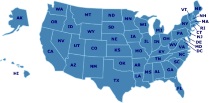Community Colleges
Many community colleges around the country have opened their doors to homeschooled teenagers, giving them an opportunity to start their college careers early, to gain classroom experience and college credit, to challenge them with more difficult materials, and to expand their horizons. Many parents look to community colleges to provide instruction in materials that they are not well suited to teach themselves.
Links
American Association of Community Colleges (AACC)
Founded in 1920, the American Association of Community Colleges (AACC) has, over four decades, become the leading proponent and the national “voice for community colleges.” Today, AACC’s membership represents close to 95 percent of all accredited U.S. two-year community, junior and technical colleges and their 10.5 million students, as well as a growing number of international members in Puerto Rico, Japan, Great Britain, Korea, and the United Arab Emirates. The colleges are the largest and fastest-growing sector of U.S. higher education, enrolling close to half (45 percent) of all U.S. undergraduates. AACC supports and promotes its member colleges through policy initiatives, innovative programs, research and information and strategic outreach to business and industry and the national news media.
And What About College?: How Homeschooling Can Lead to Admissions to the Best Colleges & Universities
Get all your questions about helping your homeschooled student apply and get accepted to college answered with this resource. It discusses transcripts, diplomas, education choices, online colleges, and more. If you are worried about whether your homeschooled student can have a successful college search, then this book will help allay those fears and offers good support and information.
Featured Resources
As an Amazon Associate, we earn from qualifying purchases. We get commissions for purchases made through links on this site.
Greenleaf Press
Greenleaf Press is a small family-owned and operated publisher and supplier of quality books for children. They are committed to "twaddle-free", living books, and approach teaching history to children using biography and chronology. You will find sections in the catalog covering each major historical period in order, with a variety of biographies, reference books, and historical fiction. For Israel, Egypt, Greece, Rome, the Middle Ages, and the Renaissance and Reformation there are Greenleaf Stu...
Bob Books
Bob Books are organized into sets that progress in level as your child learns. They have cute stories and darling illustrations. These books are perfect for children ages 4 to 8.
Bob Books First! Level A, Set 1
Bob Books First! Level A, Set 2
Bob Books First! Level B, Set 2
Bob Books First! Level C, Set 1
Idea Book For Cuisenaire Rods At The Intermediate Level
Grades 2-5. Idea Book designed for use with Cuisenaire Rods.
Kids' Poems (Grades 1)
Regie Routman shares her delightful selection of free verse poems written by first graders that will inspire your second graders to think, I can write poems like this too! Regie provides strategies for using kids' poems as models to guide children to write poems about things they know and care about: learning to skate, disliking asparagus, playing with a best friend, and more. She describes the way she invites children to study the model poem, beginning by asking kids, What do you notice? She sh...
Noah Webster's Reading Handbook
This is the historic text (originally called the Blue-Backed Speller) that has been updated to teach phonics/beginning reading. The blends and words in this reader are arranged to correlate with the sequence in which the special phonics sounds are taught. This reader is an invaluable teaching tool for children who need extra practice in the application of phonics rules. Find out more here.



